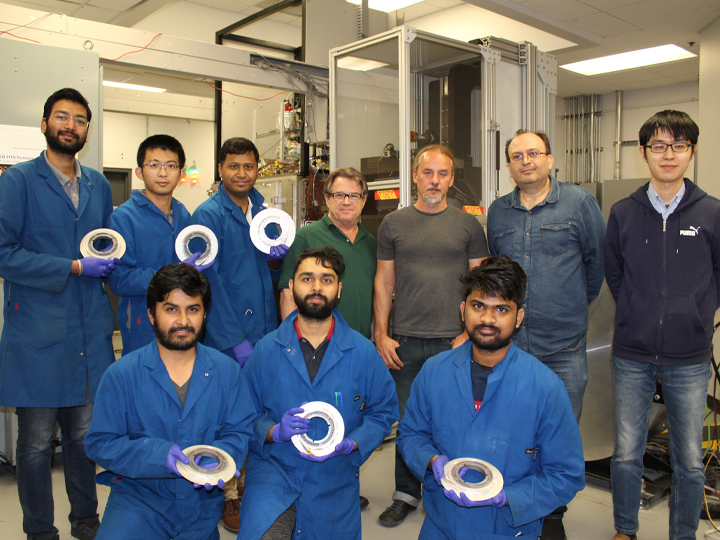
The Department of Energy (DOE) posed a challenge: to scale up energy technology and connectivity to be more efficient and, at the same time, to lower CO2 emissions and costs. Venkat Selvamanickam, M.D. Anderson Chair Professor of Mechanical Engineering at the UH Cullen College of Engineering, director of the Advanced Manufacturing Institute and head of the Selva Research Group, whose work in the superconducting arena has gained many accolades, was up for the challenge. The energy transition is right around the corner and it is no longer efficient to use copper and aluminum wire for conducting electricity. Selva Research Group was sure there was a solution.
Huge industrial-sized motors use coils of wire to conduct electricity and each coil requires thousands of meters of electrical wire to do its job. Replacing copper wire in the motors with superconductor wire can improve the motor efficiency and reduce CO2 emissions, but superconductor wires are expensive. In a $4.5M program on Advanced Manufacturing of Superconductor Wire for Next Generation Machines funded by the U.S. Department of Energy, Selva’s solution was a new superconductor manufacturing process to quadruple the wire performance and reduce unit wire cost. His group achieved this goal in short wire lengths but a big challenge was to scale up the technology to 50 meters, the minimum needed to demonstrate manufacturability. Every one of the multiple layers of the tape he created was a complex strata of nickel alloy (for strength), silver (for transferring current) and myriad other materials.
This was no simple task. A pilot-scale superconductor manufacturing equipment had to be specially designed and built for producing the new superconductor wire. Each time another layer was added to the thin tape-like wire (in fact, it resembles electrical tape when complete) the temperature, flow and other manufacturing process conditions needed to all work in tandem. Checking the tape in real time, doing quality evaluation and knowing how to tweak the process were all crucial to the final product working. “You need to know how to handle the tape, and make sure it’s not too fragile or damaged too easily,” said Selvamanickam.
After many trials, Selva Research Group created the 50-meter tape with four times the performance of commercial superconductor wire. Many spools of 50-meter tapes have been manufactured and will be tested it in a motor coil in UH’s Technology Bridge, the incubator for many commercialization and technology transfer activities.
Taking this invention to commercialization and production is what the team is focusing on now. Chris Taylor, executive director of the UH Office of Technology Transfer and Innovation said of the tape: “This technology has the chance to be used in a broad range of applications and this production milestone by Selva is one step closer to increasing its utilization, scalability and commercial potential in the global marketplace. It’s exciting to see his work establish UH and Technology Bridge as one of the epicenters of the superconductivity innovation space.”
Selva Research Group was one of 10 competitors to win the first stage of the U.S. Department of Energy’s prestigious Conductivity-enhanced materials for Affordable, Breakthrough Leapfrog Electric and thermal applications (CABLE) Prize. The three-stage competition will award up to $4.5 million to encourage the development of new materials that enhance conductivity. Each winning team earned a $25,000 cash prize and a stipend for third-party conductivity testing in the second stage of the competition.